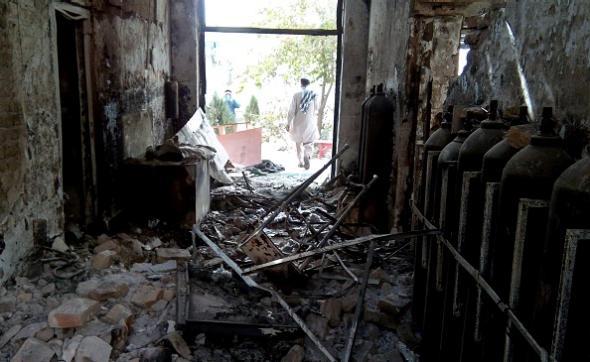The United States’ official story about the bombing of a Doctors Without Borders (Médecins Sans Frontières/MSF) hospital in Kunduz, Afghanistan, on Oct. 3, 2015—an incident in which 42 people were killed—is that American personnel accidentally attacked the hospital in the mistaken belief that they were striking a different nearby building from which Taliban forces were firing. A New York Times Magazine investigation into the incident by Matthieu Aikins doesn’t challenge that conclusion, strictly speaking. But it makes a persuasive case that Afghan government fighters had become erroneously convinced that the Taliban was using the MSF facility as a command center—and that Afghan fighters gave U.S. forces the crucial information that led to the hospital’s destruction.
U.S. forces are not really supposed to still be fighting in Afghanistan; they’re ostensibly there just to advise our Afghan allies and to carry out operations against al-Qaida and ISIS. But when the regional capital of Kunduz was overrun by the Taliban, U.S. forces were pressed into emergency duty to help retake it. On the night of Oct. 3, everyone agrees, American soldiers and air personnel were providing support for an Afghan force called the KKA that was ostensibly attacking a government building in which Taliban fighters were holed up. That government building was across a field from the MSF hospital. When the U.S. AC-130 gunship personnel who believed they were targeting the government building asked the U.S. commander on the ground (Maj. Michael Hutchinson) for a visual description of the target, the description that the Afghan forces supplied to Hutchinson—according to details that are included but downplayed in the U.S. military’s own report on the incident—matched the hospital, not the government building. According to the Times story, Afghan forces “gave a description of a ‘long T-shaped building’ with a north-facing gate, which [Hutchinson] in turn passed to the gunship.” More from the Times:
Maj. Gen. William Hickman, who led the military’s investigation, described this as “an ambiguous physical description” that “appeared to match the M.S.F. trauma center.” But it’s actually a rather specific description that corresponds to M.S.F.’s distinctive layout.
Again, the information about the Afghan targeting description is actually in the U.S.’s account of what happened. But what the Times piece adds is significant evidence that Afghan forces on the ground in Kunduz were convinced that MSF personnel were giving inappropriate aid to the Taliban and that the hospital was being used as a Taliban command center. Writes Aikins:
When I visited Kunduz in November, their anger was still surprisingly raw, despite the recent destruction of the hospital. “They give them medicine; they transport and treat their injured,” [Col. Abdullah] Gard, the commander of the [Afghan police] quick-reaction force, told me. “Their existence is a big problem for us.” And though the hospital treated many more wounded for the government, there were rumors that M.S.F. had carried out unnecessary amputations on them, according to Fawzia Yaftali, a member of the provincial council. “The general perception was that M.S.F. supported the Taliban,” she said.
Col. Abdullah Gard also claimed to Aikins that the MSF helped hide a Taliban commander:
“They hid him,” Gard told me, without offering any evidence. His men had accompanied the police commandos to the hospital. “The people who work there are traitors, all of them.”
MSF personnel treat all injured combatants in combat zones, and Aikins found no evidence that the MSF had actually aided the Taliban in an inappropriate or biased way. Some Taliban personnel may have used their radios to communicate while on site at the hospital, however, creating confusion:
These unconfirmed reports were lent additional weight by signals intelligence. Yaftali, the [Afghan] K.K.A. commander, told me that his unit’s Wolfhound radio direction finders, which allowed them to determine the range and bearing of enemy radios, picked up Taliban transmissions from inside the hospital. “We located about 10 to 15 radios from there,” he said. “The Taliban were inside and outside the hospital.”
The Times flatly says the idea that the Taliban were using the hospital as a base—or firing from it, as some Afghans suggested—was a “false conclusion.” But a number of different Afghan combatants in Kunduz clearly believed it to be true. And, to reiterate, the Times says the description that Afghan combatants gave to Hutchinson matches the hospital rather than the other potential target nearby. Those facts, taken together, suggest that the attack could have been intentional. But what the Times was not able to find out was which Afghan fighters actually supplied the targeting description to Hutchinson, the U.S. commander on the ground. Those as-yet-unidentified individuals would be the only ones who know for sure whether the bombing of the hospital was ultimately a mistake or whether the targeting description was given with the intention of bringing about its destruction.
The U.S. military apparently considers the matter closed, though, and there would seem to be little incentive for any Afghan fighters to admit they intentionally triggered an attack that the MSF—a widely respected international organization—calls a violation of the laws of war. Why did 42 people die at a hospital in Kunduz last October? We still don’t know.
